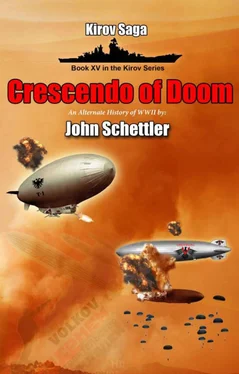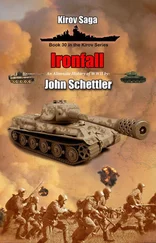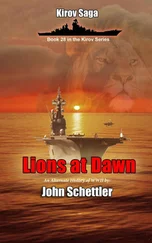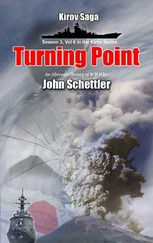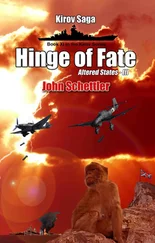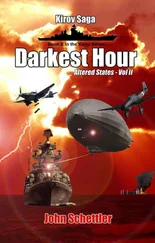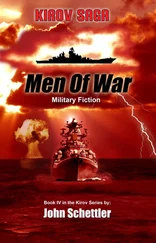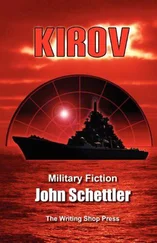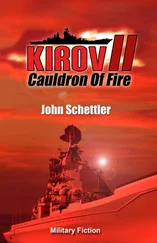The ship seemed to gasp, and then a rain of water fell from the bulbous nose as more ballast was vented. Big Red was struggling for elevation now, with at least two interior gas bags pierced by enemy shells and leaking helium, one on the verge of collapse.
Three enemy airships hung in the violent airs about her, two ‘S Class” airships at 120,000 cubic meter volume, the Samarkand and Sarkand . Above, and slightly behind was the Angren, a ship of equal size in the same “A Class” as Karpov’s old flagship Abakan . The last ship in this division, heavy cruiser Tashkent , had taken a full broadside from Krasnoyarsk , and was damaged so badly that it was forced to break off and run north for the open taiga. And Angren had taken hits as well, a deep gash gouged in the brow of the ship where crews had struggled to put out a fire that threatened to burn away the outer skin.
Big Red was well named at 180,000 cubic meter volume, with six 105mm recoilless rifles and another ten smaller 76mm guns. Yet it was still outgunned by the combined weight of enemy firepower. Now the odds were about to take a dramatic shift as Tunguska loomed on the scene, bringing another twenty four main guns to the battle, with half of those being the bigger 105mm caliber. To make matters worse for the enemy, Karpov had a thousand meter elevation advantage as he approached, so all his gondola mounted rifles were going to have perfect fields of fire, while the enemy could only bring its topside mounted guns to bear on him, and these totaled only six lighter 76mm guns between all these enemy ships.
Tunguska came in with a roaring broadside against the Angren , the skies about the enemy ship blooming with dark, fiery explosions. The gunners had the range, and the next salvoes were beginning to tear into the hull of the ship, the big 105s ripping holes through the outer shell, piercing the gas bags within, and blasting away fragments of the duralumin frame. Already fighting fires, the engineers climbing the interior ladders to damage control platforms, found themselves shaken and riddled with shrapnel. Some fell from their perches on the upper interior superstructure and plummeted down into the voids between the massive gas bags.
The forward nose bag had now taken so many hits that it collapsed, and the greater buoyancy of Angren’s tail set it drifting skyward, as if the airship was going into a nosedive, even though it still hung suspended in the tumult of the raging battle. Shocked by the sudden appearance of Tunguska , a ship nearly twice its size, the frantic topside gunners on Angren were turning every weapon they had on the enemy, sending thin streams of machinegun fire up in futile defiance.
“Main gondola gunners,” Karpov shouted through the voice tube to the men below. “Hold fire until all tubes are reloaded. Hit that damn ship amidships with one salvo on my command…. Ready… Fire!”
The resulting fire from all the rifles on the main gondola blasted into the heart of the enemy ship, tearing a massive hole in her side to expose the interior frame. There Karpov could see that the number three gas bag had been rent asunder, and was collapsing like a wet rag, the linings burning and soon engulfing the ship in choking black smoke. It was a fatal blow, and then there came two secondary explosions when the fires found reserve oxygen tanks. The resulting infusion of oxygen fed the flames, and the bridge crews watched the one nightmare they all secretly feared, the rapid, burning death of the airship, as fires engulfed it from bow to stern, and men fell, or leapt, from gondolas, preferring the headlong fall to the terror of a fiery death.
Angren hung in the sky, seeming to roll to one side for one brief moment, and then began to fall, the weight of the duralumin frame and gondolas overcoming all remaining buoyancy. It was now a fair fight, at least where ship numbers were counted. Yet with the loss of Angren , the captains of the two S Class ships could now clearly see that they were overmatched. Tunguska might have easily beaten them both, and though bruised and bleeding, Big Red was still throwing hard punches with its 105s.
Samarkand was the first to turn north, thinking to follow in the wake of the now distant heavy cruiser Tashkent . The Captain of Sarkand saw his sister ship turn, and knew that speed and maneuverability was now his only salvation. Both ships ran for the nearest cloud they could find, the skies about them pocked with explosions as they fled. The gunners began to cheer as the enemy turned, and Karpov smiled.
Big Red would live to fight another day. He was already re-writing the book Tyrenkov had found in that excursion up the stairs of the railway inn.
“Tyrenkov!” Karpov ordered. “Signal all ships to make for Ilanskiy. Tell them Vladimir Karpov is back, and ready for a fight!”
* * *
Kymchekstood in the open hatch to the armored command capsule where Volkov huddled. He saw the broken bottle of brandy on the deck, the sharp shards of glass a cruel microcosm of what had befallen the fleet. Volkov had thought to sip his brandy as he watched the battle in sedate isolation here, but the appearance of Tunguska had shaken the fleet to its core.
Two ships, Pavlodar and Talgar , had already been dispatched home after the initial battle that downed the enemy battleship Yakutsk . Salsk had been immolated by that dreadful fire bomb Karpov had deployed, and Sochi was smashed by those rockets. Now news came that Angren was down, Tashkent battered and fleeing north with the two S Class ships of that division.
“ Samarkand and Sarkand are still battle worthy,” said Kymchek, trying to soften the blow as he reported. “They are steering for Ilanskiy as ordered, and will join our division there. If Tashkent can control her fires and stay in the fight, that will still give us six airships there when we reform. Anapa was the only ship to escape that surprise attack on the Caspian Division and got her troops down safely. She’ll join us directly.”
“Half the fleet is out of action!” Volkov blustered. “Where did Karpov come from? How did he manage to get a ship of that size in here without a single sighting from anyone in the fleet?” He shook his head, deeply bothered, his eyes moving about the confined space of the capsule as if he were a caged tiger, glowering to break free and get at his enemy. Then he clenched his jaw, a smoldering fire in his eyes beneath the thick gray hair, and reached for his map.
“What is happening on the ground?” he asked tersely.
“Most every ship was able to deploy troops,” said Kymchek. “We got 1500 men down, some northeast of Kansk, and the main body north of Ilanskiy.”
The “battalions” that the airships carried were really no more than large company sized units, though they were well armed, and among the best troops in the army. Orenburg could deploy about 200 men, with most of the other ships capable of lifting between 100 and 150. Volkov’s air mobile “division” would therefore not be much more than a single brigade in actual size, until fresh troops could be air lifted from the western front. Kymchek had warned him they would be outnumbered on the ground, with a full Siberian division occupying the area from Kansk to Ilanskiy. Yet Volkov had assumed he would quickly overpower the smaller Siberian airship fleet, and therefore have complete air superiority over the battlefield to pound the enemy from above.
The sudden appearance of Tunguska had changed all that. Now the fleet might have a hard fight when it reached Ilanskiy. They expected at least two other Siberian airships were lurking there on overwatch, the Abakan and Angara , the two ships that had successfully defended the place during the first raid mounted by Volkov, albeit with a little help from Kandemir Troyak and the heavy weapons fielded by the Russian Marines. With Krasnoyarsk and Tunguska now maneuvering to Ilanskiy, the odds were not as wide as Volkov had hoped.
Читать дальше
